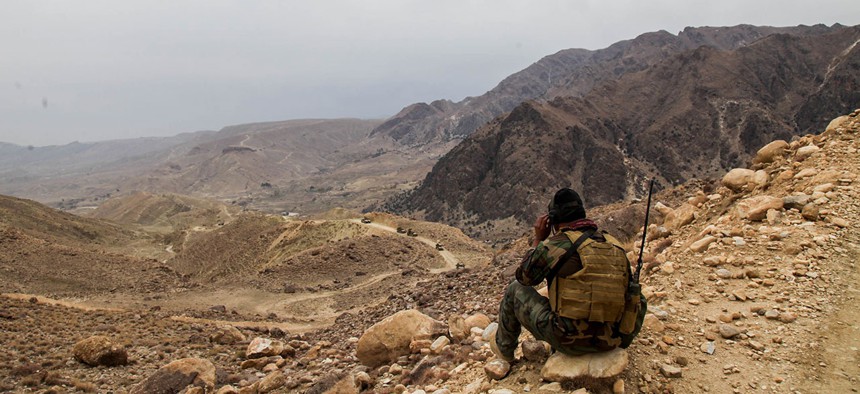
An Afghan 8th Special Operations Kandak Commando provides early warning for a convoy from a mountain top in Wach Kot Valley, Nangarhar province in December. Staff Sgt. Matthew Klene/U.S. Army
Peace Through Bombings: The U.S. Strategy in Afghanistan
The goal of negotiating with the Taliban is at odds with President Trump’s statements.
Pummeling someone into reconciliation might seem like a curious strategy. But that’s what the Trump administration is proposing to do to the Taliban as it seeks to bring an end to the war in Afghanistan.
“We will do everything we can to support the ANDSF fight against the Taliban in order to drive them to the negotiating table,” Randall Schriver, the assistant secretary of defense, said Tuesday to the Senate Foreign Relations Committee, referring to the Afghan National Defense and Security Forces. “Fundamentally, our goal is to convince the Taliban’s senior leadership that its goals are better pursued through political negotiation rather than violence.” Put another way, as Brigadier General Lance Bunch, who heads the the air campaign in Afghanistan, did in an interview with Defense One: “This is all part of our overarching strategy to continue to put pressure on the Taliban until they realize they’ve basically got a binary choice: They can negotiate and reconcile, or live in irrelevance and die. We’ll continue to go until the Taliban reconcile.”
President Trump, as part of his strategy for the longest U.S. war, has reluctantly sent more Americans to Afghanistan. There are now 14,000 U.S. troops in the country, with plans to send another 1,000. At the height of the war on terrorism, there were about 100,000 U.S. troops in the country. Since that time, the Taliban has re-emerged as a potent force. It now controls about one-third of Afghanistan, more territory than at any point since the U.S.-led invasion in 2001.
Although the remarks by Schriver and Bunch reflect Trump’s broader Afghan policy, they also appeared to contradict his assertion last month that “[we] don’t want to talk with the Taliban. There may be a time, but it’s going to be a long time.” On Tuesday, John Sullivan, the deputy secretary of state, told senators the president’s remarks were a reaction to last month’s fatal attacks, claimed by the Taliban, in Kabul. “Significant elements of the Taliban are not prepared to negotiate,” Sullivan told some skeptical lawmakers. “And it may take a long time before they are willing to negotiate. That was the thrust of the president’s remarks.”
This apparent dissonance between the president’s public proclamations and his administration’s stated policies isn’t new, however. Since his inauguration in January 2017, he has sent conflicting messages about NATO, the crisis in Qatar, North Korea, Russia, and, now, Afghanistan.
Sometimes, this dissonance has yielded results. Take Qatar, a U.S. ally that has long been criticized for its ties to groups such as Hamas and the Muslim Brotherhood. Eight months ago, its Arab neighbors imposed a blockade against it, in part as a punishment for those ties. Washington’s response was at first chaotic, but since that time Qatar has publicly said it is cooperating with the U.S. on counterterrorism initiatives—perhaps because it needs to address the perception in the U.S. that it supports terrorist groups.
The Taliban, by no means a U.S. ally, is unlikely to be motivated by the same logic—especially as it continues to enjoy support from the Pakistani military, a major power broker in Afghanistan. But Washington is confident because of its decisive military victory over ISIS in Syria and Iraq, which was achieved with the help of an international coalition. It is also confident because Trump’s Afghan strategy, along with the military effort, includes increased pressure on Pakistan in order to change its policy toward the Taliban.
Sullivan told senators Trump’s strategy was showing “some signs of progress,” adding that the Taliban’s momentum is beginning to slow on the battlefield. The new U.S. military strategy could be one reason for this, but fighting in Afghanistan typically slows down during the winter and resumes in the spring. Neither Sullivan nor Schriver could offer details on whether the Taliban has grown, shrunk, or maintained its size. They said that picture would become clearer only when the fighting season resumed.
Ultimately, however, the U.S. policy in Afghanistan calls for an Afghan-led reconciliation process that includes all regional players. “We’ve engaged in discussions with the governments in both Kabul and Islamabad on the need for a peace process to resolve the security situation in Afghanistan … including the Taliban,” Sullivan said. “What we haven’t seen, however, is any inclination from … significant elements of the Taliban that are still engaging in horrific acts of terrorist violence” that they are willing to “engage in a discussion at a peace conference.”
The U.S. hopes its strategy of pummeling the Taliban will persuade the group. But as the Taliban’s spokesman said in response to Trump’s remarks: “If you insist upon war, our mujahideen will not welcome you with roses.”






